Antiquities: shshsh, sssssss, VOIP, BBS and other modem friends
I am a little wrong collecting old things. I do not really care about the appearance, the availability of documentation and other attributes of this vintage. When I buy another old laptop or computer, or PDA, I always want to attach them to business, so that they don’t stand idle and collect dust. It is not simple. If devices of the beginning of the two thousandths can be used, albeit with restrictions, for everyday tasks, then with the computers of the nineties this will not work. They need adequate programs and games for the epoch. There are no problems with this, but the network is more complicated.

There are plenty of ways to connect to the Internet, even Windows 95, at least DOS, but why? In the modern web, old computers have nothing to do; for them, it’s rather necessary to recreate the Internet twenty years ago. But then the matter was not limited only to the Internet. Moreover, he was expensive, and it was not enough. My first computer network is Fidonet, and I learned about it by dialing a modem up to two or three local BBSs. But this is interesting. The end of 2018 is the time to recreate the infrastructure, the idea of which originated in the distant 1978. Today is a story about a project that I have been slowly sawing for half a year already, a story about telephone wires, modems and vintage text communication.
I keep notes on my museum exhibits in real time in Telegram . On Tuesdays, I collect clippings from old computer magazines: in the first issue there was a review of hardware and prices for 1986, in the second one laptops from there, the third one is dedicated to the IBM PS / 2 series introduced in 1987.
CONNECT 19200
The modem connection began to be used more or less massively (as usual in the defense industry) at the end of the fifties, although the very concept of using a phone for data transfer dates back to the twenties of the last century, or even further, if you assign the telegraph to a distant relative of the modem. In the seventies, a typical modem was a stand for a handset, which he whistled at 300 bits per second. Approximately in this form, the modems survived until the early eighties, gradually turning into automated devices capable of dialing a number and answering incoming calls. At the same time, the data transfer rate increased first to 1200, then to 2400 and 4800 bits per second. In 1994, the V.34 standard was finalized, providing speeds of up to 28,800 bps. Next stop - 33600, and then - the final, 56k,
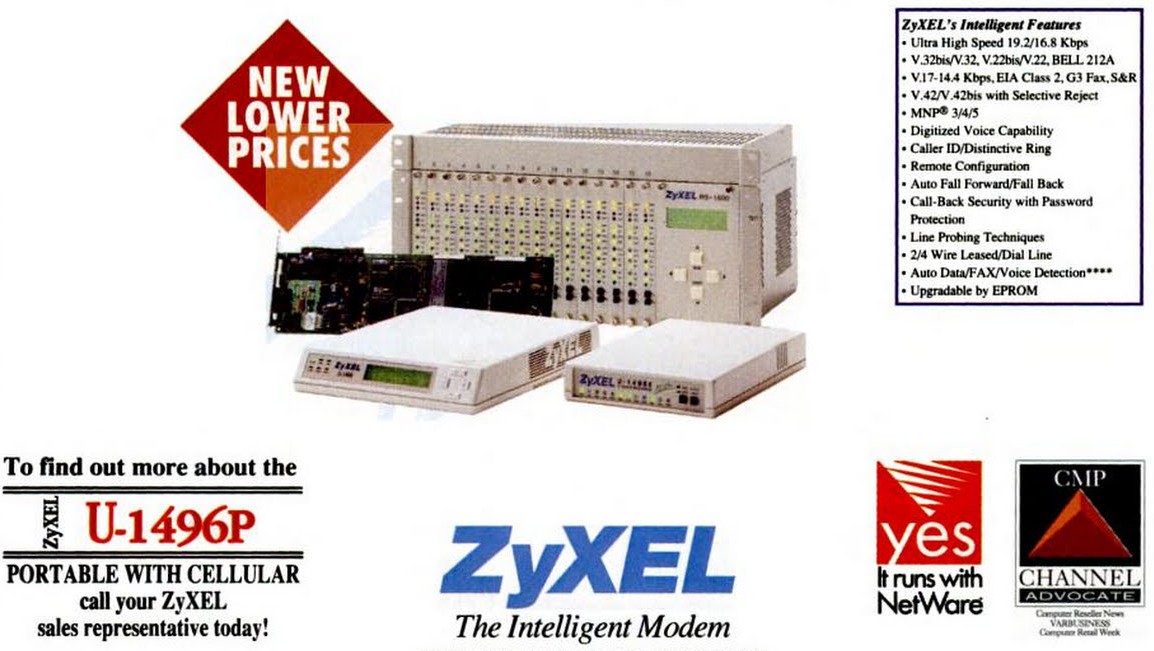
I will end this super-short insight into history with my own experience. I actively used a modem for Internet access until 2003, then the ADSL line appeared first, first at 128, and then at 256 kilobits per second. The problem of the ever-busy home phone disappeared, and then the phone itself evaporated. Modems - this seems to be not the most suitable thing to nostalgic about the past times. All the nineties, they caused a lot of frustration, not very reliably working on not differing high quality telephone lines. To get through to the fidosh node, and then to the Internet, keep the connection to download the very necessary file, turn off the pictures for speed - this was so-so experience.
But now, 15 years after the last modem was sent to retire, this part of computer history is of interest. Moreover, almost all of my laptops from the nineties are equipped with a built-in modem. Though call me, just nowhere. Even not so, the biggest problem - there is no telephone line, in general. It is from this hopeless position that my research began this spring.
VOIP to the rescue
It would seem that the easiest way is to connect the two modems to each other, whistle and calm down. But no, it does not work, or rather (as the last couple of weeks to sort things out in chat), only some advanced modems are able to connect via a dedicated line, and my embedded ones do not apply to them. Or you may need to emulate the properties of a telephone line with a battery, a capacitor, and such and such a mother. Not an option, especially, well, I'll call myself, write to the terminal, so what? If the nearest PBX is not available, you need to build your own. In fact, it is easier to score on modems, and send bytes directly to the serial port, even from the Internet, even though. But more about that some other time.
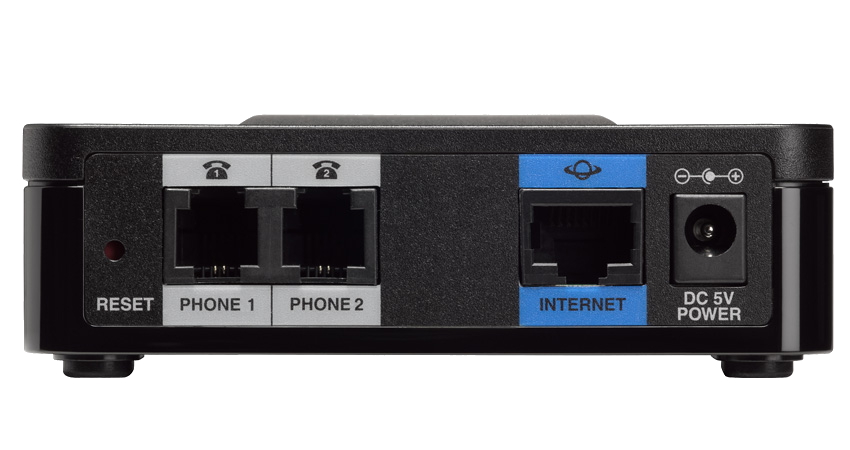
At the beginning of summer, the Linksys PAP2T VOIP Adapter ordered in China arrives - one of the most inexpensive solutions for conducting a telephone line over the Internet. It has two ports, and it is possible to hold two telephone lines at once - by the standards of the nineties, this is an unattainable luxury. I connect, configure, conjure with the firewall settings, fasten the old radiotelephone - it works! But not for long. Whether defective, or a fake device is mercilessly heated and every 10-15 minutes, hangs up the telephone part. I struggle with a toad and order a more modern analogue with similar characteristics: Cisco SPA112. Too two lines, I screw them two SIP-accounts. Successfully calling from one phone to another. I connect modems from two sides and finally hear these divine sounds.
Or not these. Or can not hear. The connection occurs, but the data is not transmitted, and after a minute or two the connection falls off. What's the matter? Although we are now streaming video over the Internet with a bit rate of units and tens of megabits, the most advanced standard for IP-telephony, G.711 , works with a 64-kilobit-wide communication channel per second. Others are even more economical. I would be happy to highlight more, but I can not. VOIP-adapters are primarily sharpened for voice communication, and modems - well, so, if possible. Many features included by default, such as echo cancellation, make a modem connection impossible.

I will not argue that I have studied this topic to the end. I went through the settings for a long time, studying (rather rare) evidence of successful use of a modem through a digital channel. It is imperative that you limit the connection possibilities only to the relatively gentle G.711 codec. But all the other settings? The decisive moment occurred when I discovered that for some reason I have UDP protocol installed as a transport, which is prone to easily lose data packets. Switching to TCP, and at the same time turning off all the built-in methods for detecting data (sharpened for faxing) this fall gave a stable result: a connection at a speed of 9600 bits per second, capable of holding a few tens of minutes.
How I did not buy Courier
Not all modems are equally useful. At the end of the industry, cheap models have gained popularity, in which all signal processing is transferred to the processor. They had serious problems with support in Linux because of the proprietary code base, and the slow computers of the beginning of the two thousandths were easily inhibited. Such a device, named Lucent WinModem, is installed in my ThinkPad T22 laptop. Older IBM notebook models are equipped with a tricky MWave digital signal processor that serves both a modem and sound card. It can be assumed that the best modem is an external, fully autonomous device. Now they are relatively inexpensive, and I decide to buy the best - USR Courier.
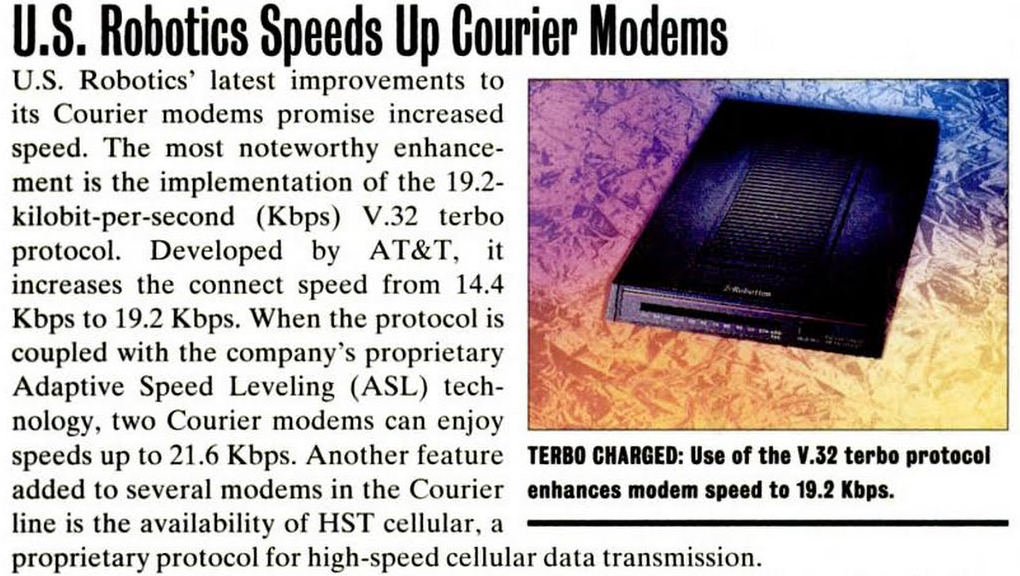
I make an order for a new device in a box, and a week later, to me, comes, USR Sportster. The seller confused the parcel and sent me a cheaper lot. And even the compensation of a part of the cost could not overcome my sadness. Well, in the nineties, my working modem was the Zyxel U1496E +, a legendary model, but not fast, with devices from other manufacturers capable of working only at 14400 bps, but holding this speed (or at least 9600) with a stranglehold. The new “sprat,” even with V.92 support, and even made in a classic package with a hardware switch, is a good starting point.

The modem came from the US, and I found that the complete power supply can only work with a 110 volt network. I had to order an analogue with a European outlet. Finally, it was necessary to pick up a serial cable. An ambush also came out here: I had accumulated a lot of wires, but everyone came up to the computer, then to the modem strictly with one end. As a result, I assembled Frankenstein from three different cables.
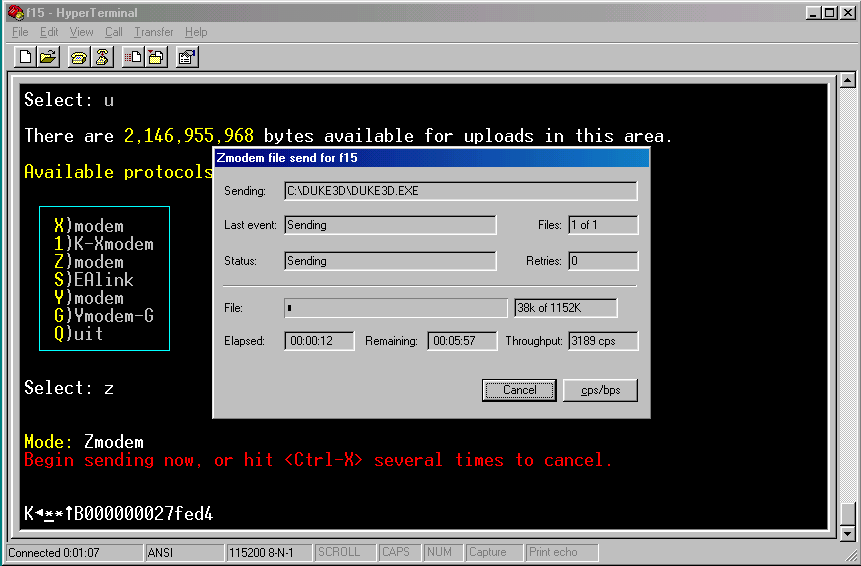
After the ritual with the initialization settings, it was possible to raise the speed to 33600, with a stable connection, and for my vintage-modern telephone line this is, perhaps, the maximum possible.
BBS
I decided to restore my own modem infrastructure from the nineties, though on a much more modern hardware. To do this, I took one of my 1998 ThinkPad 600 notebooks with a Pentium II 266 MHz processor, a specific instance was provided with 48 megabytes of RAM. Maximum - 512, but I do not need as much. The operating system, like more than twenty years ago, is Windows 95. The software for a BBS is Maximus, commercial at one time, and released at the beginning of the two thousandth for free bread with open source. On the developer site Maximus now selling clothes.
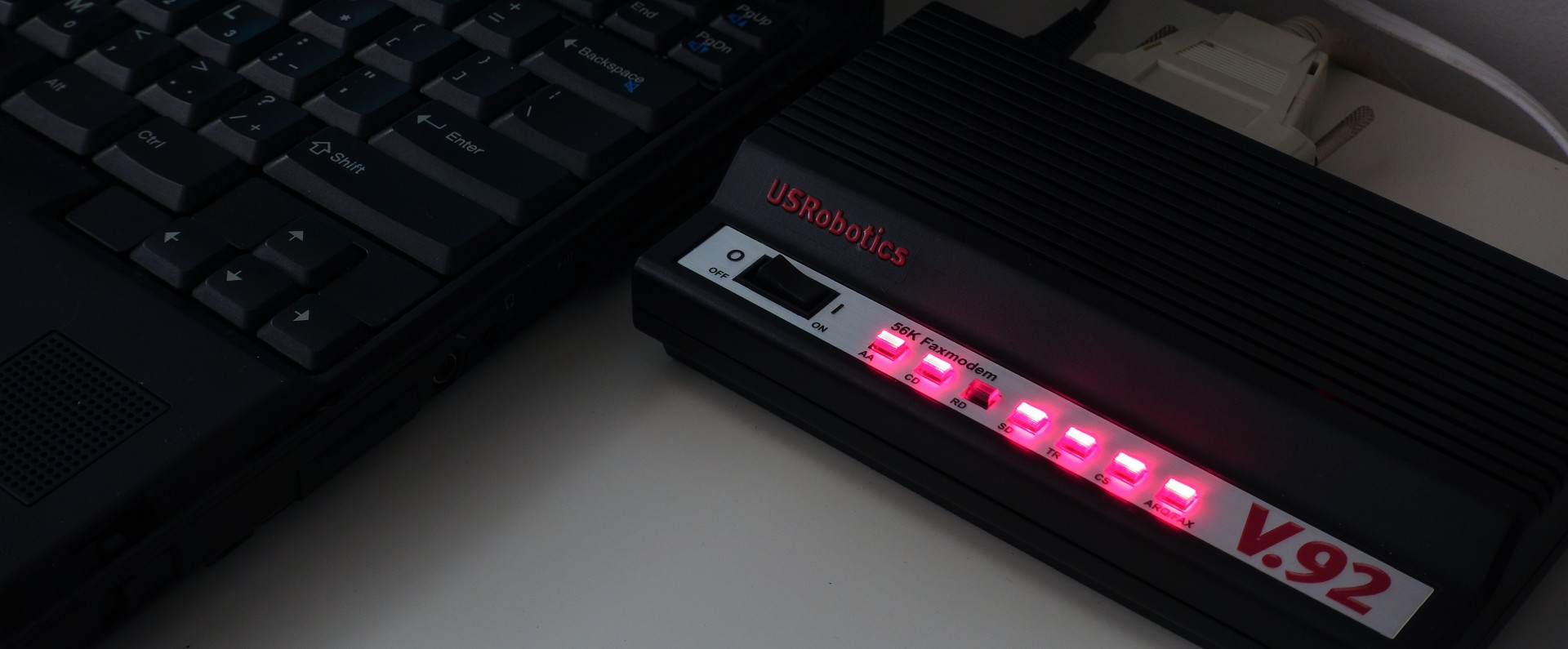
When you try to do something really working on the old hardware, in your experience there is less nostalgia and more frustration. I conducted the tests on the English version of Windows 95, which, as it turned out, is not at all friendly with the Russian language out of the box, even after installing the appropriate language pack. I had to reinstall the purely Russian version. It was an early release of Windows 95, and it took me a couple of hours to realize that USB support — transfer files from a modern computer — is not in this version. It appeared only in the Windows update called OSR2, well, or you can pick it up from the disk with this distribution, the necessary files are still separate.
The serial port was turned off in the BIOS, and to enable it, you need an IBM utility, and for it you had to install an update of Internet Explorer to version 4.0. And at the same time he tried to pull up an “active desktop” from Windows 98. I tried to stop these attempts, and after a couple of evenings with a tambourine and crutches, everything was ready for me.
BBS - is that all? I think it's time to explain. If you want to study yourself, there is thisFive-hour film, shot in the United States at the beginning of the two thousandth. The history of the BBS began in Chicago in 1978. According to eyewitnesses, the trigger was a snow storm, but such that it was impossible to get anywhere. And if not, why not talk on the phone. Why not voice? So not interesting. For ten years, a whole industry was created around the BBS in the west, there were paid stations on hundreds of lines, sysop conferences, and much more. Almost all of this was killed over the year by the web: in 1994-1995, the number of BBS in the United States reached its peak (thousands of stations), and almost immediately a rapid decline began.

In Russia, BBS appeared a little later, and lived longer, and some still live today. According to data from the RU.BBSNEWS ehoconference systems, answering honestly, by phone, there are eight to the whole of Russia. I call to one of them: there is a connection to 14400, not bad. This means that my VOIP modem connection does not work only inside my operator. By the way, the modem pool at the Internet operator MTU Intel (now part of MTS) is still responding. Truth after the connection (at an incredible 45333 and above) nothing else happens. Why - I do not know, but sorry. One could get online through, uh, internet.
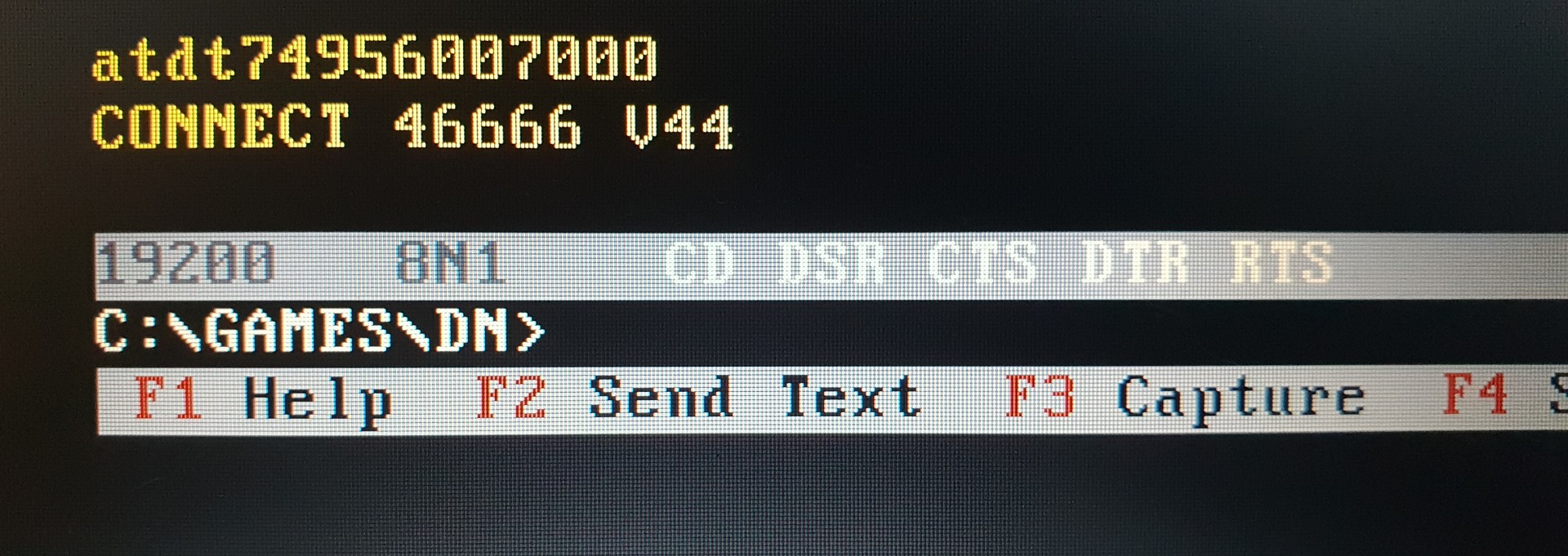
So, BBS is the larva of a computer network, a station to which as many people as there are telephone lines can connect at any time. This text terminal comes from the sixties, through which you get the opportunity to communicate with other users of the BBS, and you can read FIDO conferences. In the nineties, with the help of BBS, I learned about the existence of Fidonet, after which I started my station, first making it round-the-clock with youthful maximalism. After complaints from home to "constantly call and are silent in the phone" BBS was the night. This is all I am trying to recreate.
Maximus is quite easy to install, just download the distribution (for example, here) for your OS, there is a choice of Windows, DOS and OS / 2 (and it seems there is a port under Linux, released, so to speak, posthumously). The first launch is done locally, you need to register on behalf of the sysop or the station superuser. There are a lot of settings in configuration files, but first you need to specify the number of the serial port on which the modem hangs. The configs are then compiled - this is done to integrate the Maximus built-in programming language, for very complex scripts of interaction with users and the world around. Then we run runbbs.bat and that's it, you can call. But no, first (if you have DOS and Windows) you need to install the FOSSIL driver to communicate with the modem.
You can do nothing more, but I just have to change the full-time welcome screen to my own. In 1996, I have been drawing pseudographics for a long time in a text editor. In 2018 I just google a generator of ASCII letters and take it straight from there.

Let's see what we have by default. Filedumps , in the nineties, they play an important role. For new users, by default, a very small time limit is set for the connection - an hour, or even less. This was done partly to ensure that users do not hang on the line for hours, and let others ring out (and the sysop was given time to download mail). It was possible to raise the limit by doing something useful: you could add a beer to your sysop, or you could upload some useful file to the BBS. By default, all new files are added to the “unchecked” section, after which the sysop must hand them over to where it belongs.
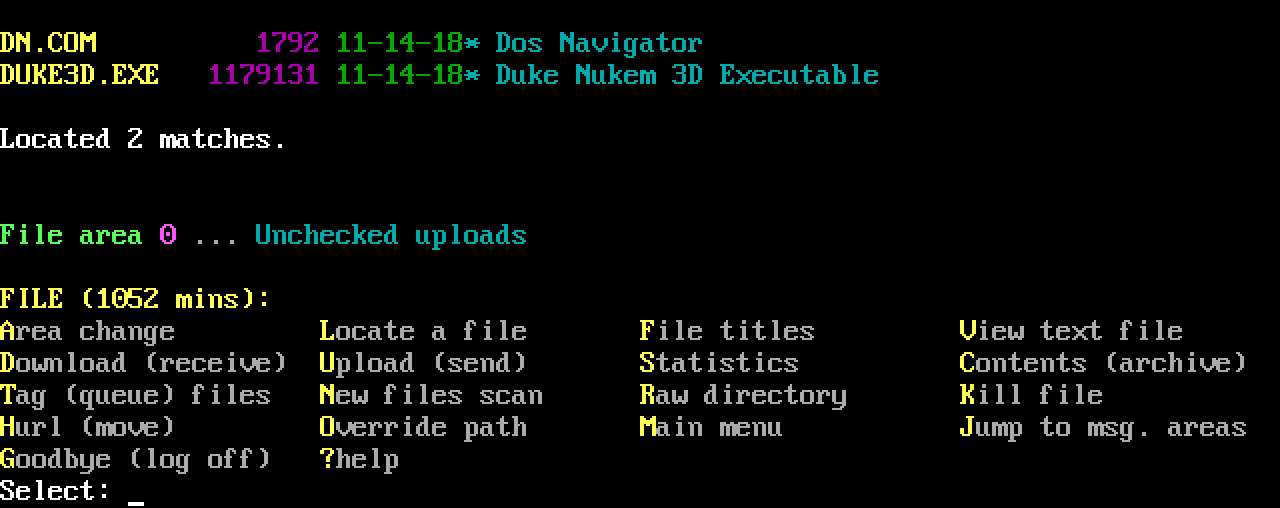
The software suite on the old BBS was traditional: drivers, books, pictures, music in MIDI (later MP3, you get tired of downloading), compact games under DOS. My BBS of the nineties was somehow called by a user with an old modem at 2400 bits per second and monstrously slowly, for several nights in a row, downloaded a one and a half megabyte movie, where Bill Gates was thrown into a cake . And so it was painfully long and unpromising that I offered him the delivery of the roller with my feet, on a diskette. The answer was a polite refusal: unsportsmanlike.

The message section contains the user's personal correspondence with the sysop, a local conference for all BBS users, and of course, those FIDO echo conferences that the Sysop is not lazy to screw on. Usually fidosh conferences were in read-on mode: in FIDO, even the network points didn’t have any particular rights, not to mention the visitors of the BBS. For my BBS, I leave lokalku and fasten a piece of the conference HUMOR.FILTERED found in the web archive . Works!
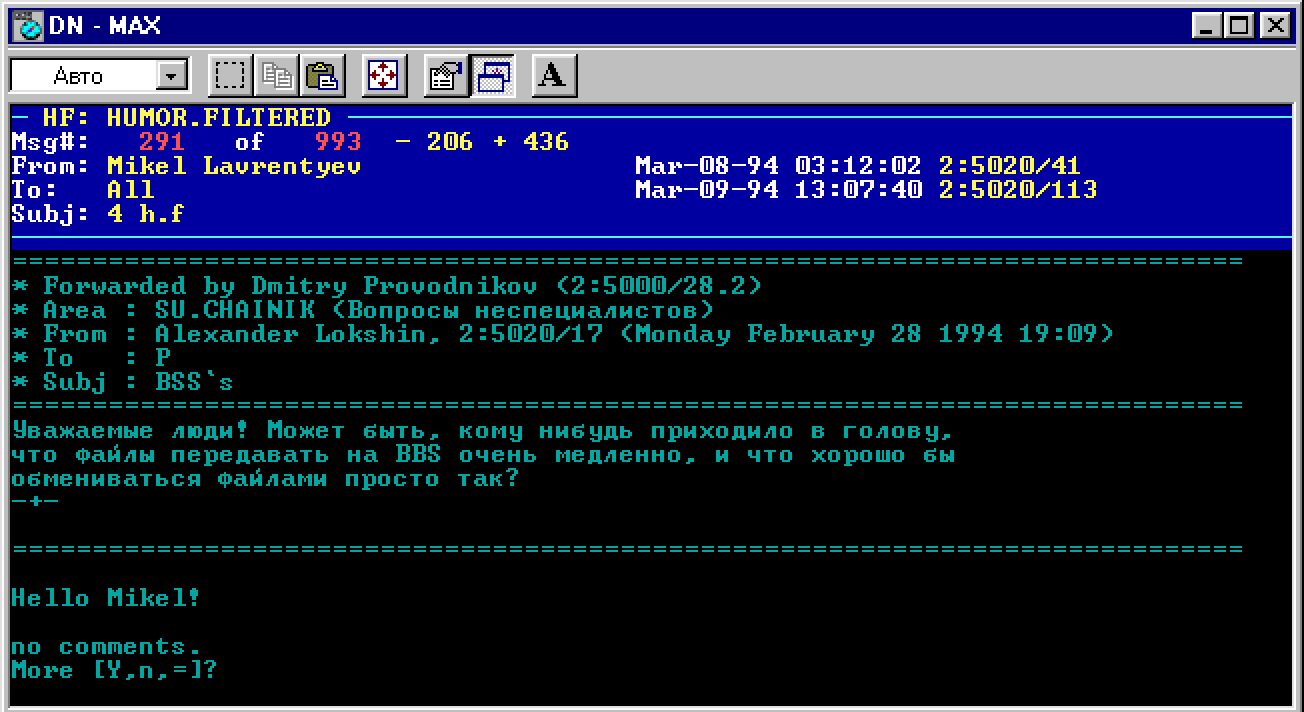
Another useful feature is simple games, but I don’t remember that it would be interesting to me even in those times. But what's really cool is the option Yell Sysop. With its help, it was possible to beat the station owner into a PC speaker and call him to a conversation. In the terminal window I sometimes spent the whole night talking. The format of communication is the most primitive: in fact, you have one screen for two, so it is advisable to wait until the other person agrees, otherwise it’s like this:
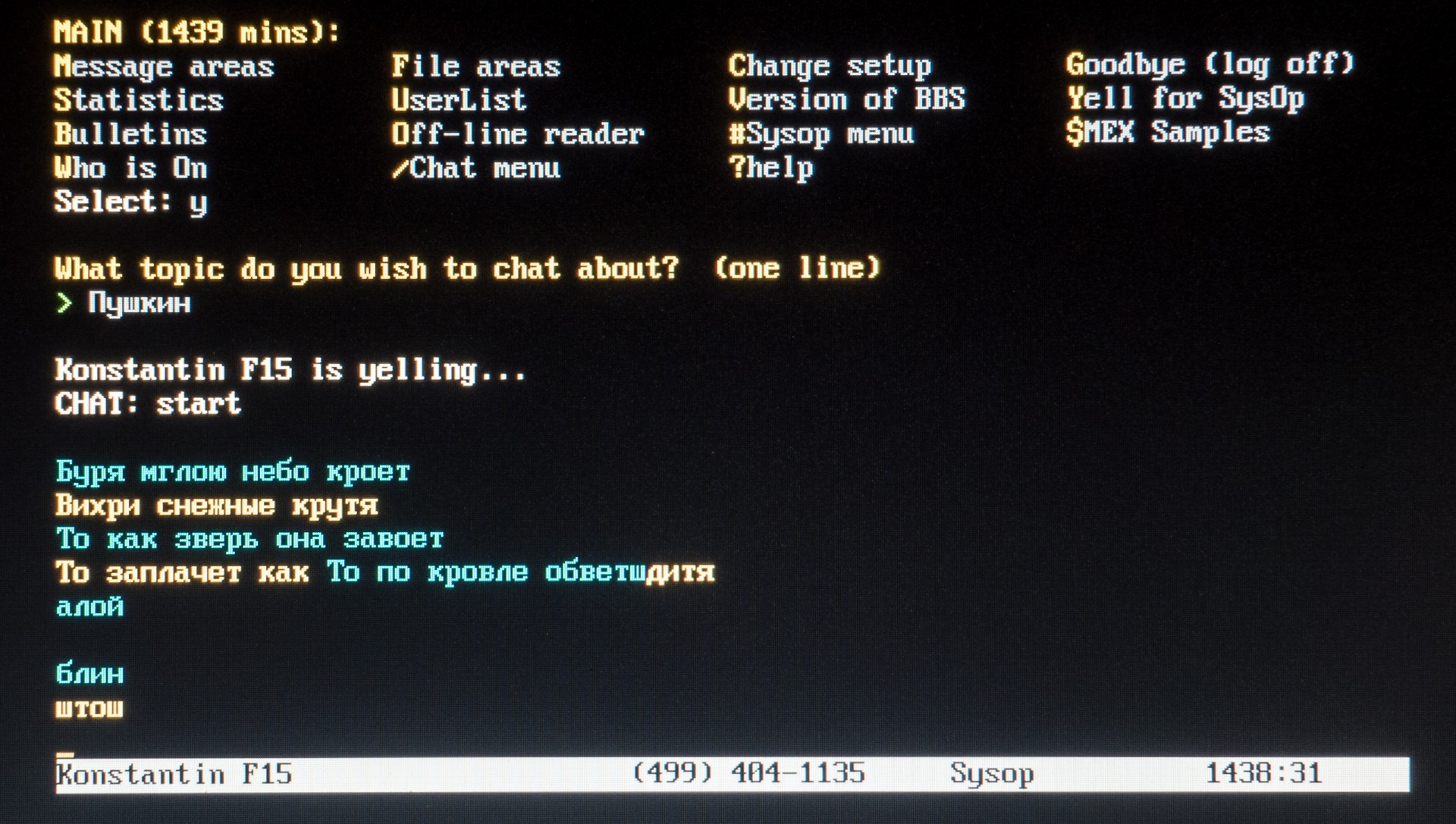
By modern standards, it is difficult to even understand how valuable BBS was in the nineties, when the Internet was simply impossible to afford - I used the network, measuring time by minutes, and only for sending and downloading email. Now, when you can find almost any file on the network, when there are hundreds of platforms for communication, when you finally do not need to dial up , the possibilities of the BBS seem primitive. But twenty years ago life was in full swing there. Unlike the early web, there is little left of this life: I don’t even know where my old computer went with all the archives in it.
BBS on the basis of ancient software is also an insecure thing: Maximus already hashes user passwords, and other programs keep them in the clear. BBS also had vulnerabilities in the processing of uploaded files. Even modern programs (such as the currently developed Mystic BBS ) by default assume a connection through the network via Telnet, the protocol is completely open and not protected from interception. This is partly why I am not going to make my BBS directly accessible from the network, it is (from a security point of view) perhaps even harder than building my own telephone exchange.
But why?
The logical conclusion of my research with the restoration was the purchase of an incoming number from a VOIP provider. Walk so walk. Does this all make sense? This is how to look. My main task was to recreate the experience of interaction with BBS from the nineties, with maximum use of vintage technology (except for wires to the telephone exchange). There is a complete success. But somehow I don't want to just turn it off and put it on the shelf. Does the BBS in 2018 have a practical meaning?
Not really. It would be possible to say that a cataclysm will occur, the Internet will turn off, and the BBS here they are working. Not in my case: the technology is tied to a permanent connection to the network. Will I now publish articles only on the BBS? Well no. In my opinion, BBS makes sense strictly as a museum piece. But this is a big and complex topic. Now my BBS is almost an empty shell. It is filled by its users, or the system operator itself. For museum purposes, it would be very cool to make available the old archives of fidosh (and maybe not only) echo conferences, in natural, so to speak, form. My experience with HUMOR.FILTERED shows that this is possible.
But this is not an easy task, and at first having taken hold of it with enthusiasm, I now remain in doubt. I'll finish them: if the story gets its continuation beyond the simple proof-of-concept, I'll write an update. And, yes, since I bought an incoming phone, call or something . If you certainly have a telephone line, and a modem, and a computer to which this modem can be connected. Phone +7 499 404 11 35. I undertake to keep the BBS in working condition for at least three months from the date of publication of this post. And we'll see.

There are plenty of ways to connect to the Internet, even Windows 95, at least DOS, but why? In the modern web, old computers have nothing to do; for them, it’s rather necessary to recreate the Internet twenty years ago. But then the matter was not limited only to the Internet. Moreover, he was expensive, and it was not enough. My first computer network is Fidonet, and I learned about it by dialing a modem up to two or three local BBSs. But this is interesting. The end of 2018 is the time to recreate the infrastructure, the idea of which originated in the distant 1978. Today is a story about a project that I have been slowly sawing for half a year already, a story about telephone wires, modems and vintage text communication.
I keep notes on my museum exhibits in real time in Telegram . On Tuesdays, I collect clippings from old computer magazines: in the first issue there was a review of hardware and prices for 1986, in the second one laptops from there, the third one is dedicated to the IBM PS / 2 series introduced in 1987.
CONNECT 19200
The modem connection began to be used more or less massively (as usual in the defense industry) at the end of the fifties, although the very concept of using a phone for data transfer dates back to the twenties of the last century, or even further, if you assign the telegraph to a distant relative of the modem. In the seventies, a typical modem was a stand for a handset, which he whistled at 300 bits per second. Approximately in this form, the modems survived until the early eighties, gradually turning into automated devices capable of dialing a number and answering incoming calls. At the same time, the data transfer rate increased first to 1200, then to 2400 and 4800 bits per second. In 1994, the V.34 standard was finalized, providing speeds of up to 28,800 bps. Next stop - 33600, and then - the final, 56k,

I will end this super-short insight into history with my own experience. I actively used a modem for Internet access until 2003, then the ADSL line appeared first, first at 128, and then at 256 kilobits per second. The problem of the ever-busy home phone disappeared, and then the phone itself evaporated. Modems - this seems to be not the most suitable thing to nostalgic about the past times. All the nineties, they caused a lot of frustration, not very reliably working on not differing high quality telephone lines. To get through to the fidosh node, and then to the Internet, keep the connection to download the very necessary file, turn off the pictures for speed - this was so-so experience.
But now, 15 years after the last modem was sent to retire, this part of computer history is of interest. Moreover, almost all of my laptops from the nineties are equipped with a built-in modem. Though call me, just nowhere. Even not so, the biggest problem - there is no telephone line, in general. It is from this hopeless position that my research began this spring.
VOIP to the rescue
It would seem that the easiest way is to connect the two modems to each other, whistle and calm down. But no, it does not work, or rather (as the last couple of weeks to sort things out in chat), only some advanced modems are able to connect via a dedicated line, and my embedded ones do not apply to them. Or you may need to emulate the properties of a telephone line with a battery, a capacitor, and such and such a mother. Not an option, especially, well, I'll call myself, write to the terminal, so what? If the nearest PBX is not available, you need to build your own. In fact, it is easier to score on modems, and send bytes directly to the serial port, even from the Internet, even though. But more about that some other time.

At the beginning of summer, the Linksys PAP2T VOIP Adapter ordered in China arrives - one of the most inexpensive solutions for conducting a telephone line over the Internet. It has two ports, and it is possible to hold two telephone lines at once - by the standards of the nineties, this is an unattainable luxury. I connect, configure, conjure with the firewall settings, fasten the old radiotelephone - it works! But not for long. Whether defective, or a fake device is mercilessly heated and every 10-15 minutes, hangs up the telephone part. I struggle with a toad and order a more modern analogue with similar characteristics: Cisco SPA112. Too two lines, I screw them two SIP-accounts. Successfully calling from one phone to another. I connect modems from two sides and finally hear these divine sounds.
Or not these. Or can not hear. The connection occurs, but the data is not transmitted, and after a minute or two the connection falls off. What's the matter? Although we are now streaming video over the Internet with a bit rate of units and tens of megabits, the most advanced standard for IP-telephony, G.711 , works with a 64-kilobit-wide communication channel per second. Others are even more economical. I would be happy to highlight more, but I can not. VOIP-adapters are primarily sharpened for voice communication, and modems - well, so, if possible. Many features included by default, such as echo cancellation, make a modem connection impossible.

I will not argue that I have studied this topic to the end. I went through the settings for a long time, studying (rather rare) evidence of successful use of a modem through a digital channel. It is imperative that you limit the connection possibilities only to the relatively gentle G.711 codec. But all the other settings? The decisive moment occurred when I discovered that for some reason I have UDP protocol installed as a transport, which is prone to easily lose data packets. Switching to TCP, and at the same time turning off all the built-in methods for detecting data (sharpened for faxing) this fall gave a stable result: a connection at a speed of 9600 bits per second, capable of holding a few tens of minutes.
How I did not buy Courier
Not all modems are equally useful. At the end of the industry, cheap models have gained popularity, in which all signal processing is transferred to the processor. They had serious problems with support in Linux because of the proprietary code base, and the slow computers of the beginning of the two thousandths were easily inhibited. Such a device, named Lucent WinModem, is installed in my ThinkPad T22 laptop. Older IBM notebook models are equipped with a tricky MWave digital signal processor that serves both a modem and sound card. It can be assumed that the best modem is an external, fully autonomous device. Now they are relatively inexpensive, and I decide to buy the best - USR Courier.

I make an order for a new device in a box, and a week later, to me, comes, USR Sportster. The seller confused the parcel and sent me a cheaper lot. And even the compensation of a part of the cost could not overcome my sadness. Well, in the nineties, my working modem was the Zyxel U1496E +, a legendary model, but not fast, with devices from other manufacturers capable of working only at 14400 bps, but holding this speed (or at least 9600) with a stranglehold. The new “sprat,” even with V.92 support, and even made in a classic package with a hardware switch, is a good starting point.

The modem came from the US, and I found that the complete power supply can only work with a 110 volt network. I had to order an analogue with a European outlet. Finally, it was necessary to pick up a serial cable. An ambush also came out here: I had accumulated a lot of wires, but everyone came up to the computer, then to the modem strictly with one end. As a result, I assembled Frankenstein from three different cables.

After the ritual with the initialization settings, it was possible to raise the speed to 33600, with a stable connection, and for my vintage-modern telephone line this is, perhaps, the maximum possible.
BBS
I decided to restore my own modem infrastructure from the nineties, though on a much more modern hardware. To do this, I took one of my 1998 ThinkPad 600 notebooks with a Pentium II 266 MHz processor, a specific instance was provided with 48 megabytes of RAM. Maximum - 512, but I do not need as much. The operating system, like more than twenty years ago, is Windows 95. The software for a BBS is Maximus, commercial at one time, and released at the beginning of the two thousandth for free bread with open source. On the developer site Maximus now selling clothes.

When you try to do something really working on the old hardware, in your experience there is less nostalgia and more frustration. I conducted the tests on the English version of Windows 95, which, as it turned out, is not at all friendly with the Russian language out of the box, even after installing the appropriate language pack. I had to reinstall the purely Russian version. It was an early release of Windows 95, and it took me a couple of hours to realize that USB support — transfer files from a modern computer — is not in this version. It appeared only in the Windows update called OSR2, well, or you can pick it up from the disk with this distribution, the necessary files are still separate.
The serial port was turned off in the BIOS, and to enable it, you need an IBM utility, and for it you had to install an update of Internet Explorer to version 4.0. And at the same time he tried to pull up an “active desktop” from Windows 98. I tried to stop these attempts, and after a couple of evenings with a tambourine and crutches, everything was ready for me.
BBS - is that all? I think it's time to explain. If you want to study yourself, there is thisFive-hour film, shot in the United States at the beginning of the two thousandth. The history of the BBS began in Chicago in 1978. According to eyewitnesses, the trigger was a snow storm, but such that it was impossible to get anywhere. And if not, why not talk on the phone. Why not voice? So not interesting. For ten years, a whole industry was created around the BBS in the west, there were paid stations on hundreds of lines, sysop conferences, and much more. Almost all of this was killed over the year by the web: in 1994-1995, the number of BBS in the United States reached its peak (thousands of stations), and almost immediately a rapid decline began.

In Russia, BBS appeared a little later, and lived longer, and some still live today. According to data from the RU.BBSNEWS ehoconference systems, answering honestly, by phone, there are eight to the whole of Russia. I call to one of them: there is a connection to 14400, not bad. This means that my VOIP modem connection does not work only inside my operator. By the way, the modem pool at the Internet operator MTU Intel (now part of MTS) is still responding. Truth after the connection (at an incredible 45333 and above) nothing else happens. Why - I do not know, but sorry. One could get online through, uh, internet.

So, BBS is the larva of a computer network, a station to which as many people as there are telephone lines can connect at any time. This text terminal comes from the sixties, through which you get the opportunity to communicate with other users of the BBS, and you can read FIDO conferences. In the nineties, with the help of BBS, I learned about the existence of Fidonet, after which I started my station, first making it round-the-clock with youthful maximalism. After complaints from home to "constantly call and are silent in the phone" BBS was the night. This is all I am trying to recreate.
Maximus is quite easy to install, just download the distribution (for example, here) for your OS, there is a choice of Windows, DOS and OS / 2 (and it seems there is a port under Linux, released, so to speak, posthumously). The first launch is done locally, you need to register on behalf of the sysop or the station superuser. There are a lot of settings in configuration files, but first you need to specify the number of the serial port on which the modem hangs. The configs are then compiled - this is done to integrate the Maximus built-in programming language, for very complex scripts of interaction with users and the world around. Then we run runbbs.bat and that's it, you can call. But no, first (if you have DOS and Windows) you need to install the FOSSIL driver to communicate with the modem.
You can do nothing more, but I just have to change the full-time welcome screen to my own. In 1996, I have been drawing pseudographics for a long time in a text editor. In 2018 I just google a generator of ASCII letters and take it straight from there.

Let's see what we have by default. File

The software suite on the old BBS was traditional: drivers, books, pictures, music in MIDI (later MP3, you get tired of downloading), compact games under DOS. My BBS of the nineties was somehow called by a user with an old modem at 2400 bits per second and monstrously slowly, for several nights in a row, downloaded a one and a half megabyte movie, where Bill Gates was thrown into a cake . And so it was painfully long and unpromising that I offered him the delivery of the roller with my feet, on a diskette. The answer was a polite refusal: unsportsmanlike.

The message section contains the user's personal correspondence with the sysop, a local conference for all BBS users, and of course, those FIDO echo conferences that the Sysop is not lazy to screw on. Usually fidosh conferences were in read-on mode: in FIDO, even the network points didn’t have any particular rights, not to mention the visitors of the BBS. For my BBS, I leave lokalku and fasten a piece of the conference HUMOR.FILTERED found in the web archive . Works!

Another useful feature is simple games, but I don’t remember that it would be interesting to me even in those times. But what's really cool is the option Yell Sysop. With its help, it was possible to beat the station owner into a PC speaker and call him to a conversation. In the terminal window I sometimes spent the whole night talking. The format of communication is the most primitive: in fact, you have one screen for two, so it is advisable to wait until the other person agrees, otherwise it’s like this:

By modern standards, it is difficult to even understand how valuable BBS was in the nineties, when the Internet was simply impossible to afford - I used the network, measuring time by minutes, and only for sending and downloading email. Now, when you can find almost any file on the network, when there are hundreds of platforms for communication, when you finally do not need to dial up , the possibilities of the BBS seem primitive. But twenty years ago life was in full swing there. Unlike the early web, there is little left of this life: I don’t even know where my old computer went with all the archives in it.
BBS on the basis of ancient software is also an insecure thing: Maximus already hashes user passwords, and other programs keep them in the clear. BBS also had vulnerabilities in the processing of uploaded files. Even modern programs (such as the currently developed Mystic BBS ) by default assume a connection through the network via Telnet, the protocol is completely open and not protected from interception. This is partly why I am not going to make my BBS directly accessible from the network, it is (from a security point of view) perhaps even harder than building my own telephone exchange.
But why?
The logical conclusion of my research with the restoration was the purchase of an incoming number from a VOIP provider. Walk so walk. Does this all make sense? This is how to look. My main task was to recreate the experience of interaction with BBS from the nineties, with maximum use of vintage technology (except for wires to the telephone exchange). There is a complete success. But somehow I don't want to just turn it off and put it on the shelf. Does the BBS in 2018 have a practical meaning?
Not really. It would be possible to say that a cataclysm will occur, the Internet will turn off, and the BBS here they are working. Not in my case: the technology is tied to a permanent connection to the network. Will I now publish articles only on the BBS? Well no. In my opinion, BBS makes sense strictly as a museum piece. But this is a big and complex topic. Now my BBS is almost an empty shell. It is filled by its users, or the system operator itself. For museum purposes, it would be very cool to make available the old archives of fidosh (and maybe not only) echo conferences, in natural, so to speak, form. My experience with HUMOR.FILTERED shows that this is possible.
But this is not an easy task, and at first having taken hold of it with enthusiasm, I now remain in doubt. I'll finish them: if the story gets its continuation beyond the simple proof-of-concept, I'll write an update. And, yes, since I bought an incoming phone, call or something . If you certainly have a telephone line, and a modem, and a computer to which this modem can be connected. Phone +7 499 404 11 35. I undertake to keep the BBS in working condition for at least three months from the date of publication of this post. And we'll see.
